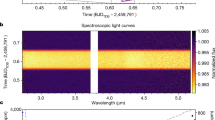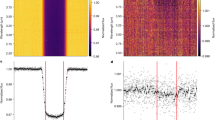Abstract
Detection of molecules using infrared spectroscopy probes the conditions and compositions of exoplanet atmospheres. Water (H2O), methane (CH4), carbon dioxide (CO2), and carbon monoxide (CO) have been detected1,2,3,4,5 in two hot Jupiters. These previous results relied on space-based telescopes that do not provide spectroscopic capability in the 2.4–5.2 μm spectral region. Here we report ground-based observations of the dayside emission spectrum for HD 189733b between 2.0–2.4 μm and 3.1–4.1 μm, where we find a bright emission feature. Where overlap with space-based instruments exists, our results are in excellent agreement with previous measurements2,6. A feature at ∼3.25 μm is unexpected and difficult to explain with models that assume local thermodynamic equilibrium (LTE) conditions at the 1 bar to 1 × 10-6 bar pressures typically sampled by infrared measurements. The most likely explanation for this feature is that it arises from non-LTE emission from CH4, similar to what is seen in the atmospheres of planets in our own Solar System7,8,9. These results suggest that non-LTE effects may need to be considered when interpreting measurements of strongly irradiated exoplanets.
This is a preview of subscription content, access via your institution
Access options
Subscribe to this journal
Receive 51 print issues and online access
$199.00 per year
only $3.90 per issue
Buy this article
- Purchase on Springer Link
- Instant access to full article PDF
Prices may be subject to local taxes which are calculated during checkout


Similar content being viewed by others
References
Tinetti, G. et al. Water vapour in the atmosphere of a transiting extrasolar planet. Nature 448, 169–171 (2007)
Swain, M. R., Vasisht, G. & Tinetti, G. The presence of methane in the atmosphere of an extrasolar planet. Nature 452, 329–331 (2008)
Grillmair, C. J. et al. Strong water absorption in the dayside emission spectrum of the planet HD 189733b. Nature 456, 767–768 (2008)
Swain, M. R. et al. Molecular signatures in the near-infrared dayside spectrum of HD 189733b. Astrophys. J. 690, L114–L117 (2009)
Swain, M. R. et al. Water, methane, and carbon dioxide present in the dayside spectrum of the exoplanet HD 209458b. Astrophys. J. 704, 1616–1221 (2009)
Charbonneau, D. et al. The broadband infrared emission spectrum of the exoplanet HD 189733b. Astrophys. J. 686, 1341–1348 (2008)
Drossart, P. et al. Fluorescence in the 3 microns bands of methane on Jupiter and Saturn from ISO/SWS observations. ESA SP 427, 169–172 (1999)
Brown, R. H. et al. Observations with the Visual and Infrared Mapping Spectrometer (VIMS) during Cassini’s flyby of Jupiter. Icarus 164, 461–470 (2003)
Kim, S. J., Geballe, T. R. & Noll, K. S. Three-micrometer CH4 line emission from Titan’s high-altitude atmosphere. Icarus 147, 588–591 (2000)
Rauscher, E. & Menou, K. Atmospheric circulation in hot Jupiters: a shallow three-dimensional model. Astrophys. J. 700, 887–897 (2009)
Showman, A. P., Cooper, C. S., Fortney, J. J. & Marley, M. S. Atmospheric circulation of hot Jupiters: three-dimensional circulation models of HD 209458b and HD 189733b with simplified forcing. Astrophys. J. 682, 559–576 (2008)
Rayner, J. T. et al. SpeX: a medium-resolution 0.8–5.5 micron spectrograph and imager for the NASA infrared telescope. Publ. Astron. Soc. Pacif. 115, 362–382 (2003)
Pagiatakis, S. D., Yin, H. & Abd El-Gelil, M. Least-squares self-coherency analysis of superconducting gravimeter records in search for the Slichter triplet. Phys. Earth Planet. Inter. 160, 108–123 (2007)
Barman, T. B. On the presence of water and global circulation in the transiting planet HD 189733b. Astrophys. J. 676, L61–L64 (2008)
Redfield, S., Endl, M., Cochran, W. D. & Koesterke, L. Sodium absorption from the exoplanetary atmosphere of HD 189733b detected in the optical transmission spectrum. Astrophys. J. 673, L87–L90 (2008)
Snellen, I. A. G., Albrecht, S., de Mooij, E. J. W. & Lee Poole, R. S. Ground-based detection of sodium in the transmission spectrum of exoplanet HD 209458b. Astron. Astrophys. 487, 357–362 (2008)
Acknowledgements
We thank S. Bus at the IRTF for several discussions regarding the operation of the SpeX instrument and for support during our observing runs. We thank the observing staff at the IRTF for their assistance and advice during observing runs. We thank L. Brown for making recommendations on molecular line lists and G. Orton for extensive discussions about the interpretation of these results. G. Tinetti was supported by the UK Sciences and Technology Facilities Council and the European Space Agency. The research described in this paper was carried out at the Jet Propulsion Laboratory, California Institute of Technology, under a contract with the National Aeronautics and Space Administration.
Author Contributions M.R.S. wrote the paper, participated in developing the calibration methods, and wrote the telescope proposals. P.D. worked on developing and testing the calibration method. C.A.G. and G.T. worked on the interpretation of the results. A.T. worked on the calibration method. G.V. and P.C. worked on calibration validation. J.B. worked on the calibration of the Spitzer data. I.J.C. worked on an early version of the calibration method. D.A. contributed to the atmospheric calibration approach. C.A. and T.H. were co-authors on the original telescope proposal and provided comments on the paper text.
Author information
Authors and Affiliations
Corresponding author
Ethics declarations
Competing interests
The authors declare no competing financial interests.
Supplementary information
Supplementary Information
This file contains Supplementary Methods and Data, Supplementary References and Supplementary Figures S1-S3 with Legends. (PDF 2676 kb)
PowerPoint slides
Rights and permissions
About this article
Cite this article
Swain, M., Deroo, P., Griffith, C. et al. A ground-based near-infrared emission spectrum of the exoplanet HD 189733b. Nature 463, 637–639 (2010). https://doi.org/10.1038/nature08775
Received:
Accepted:
Issue Date:
DOI: https://doi.org/10.1038/nature08775
This article is cited by
-
A chemical survey of exoplanets with ARIEL
Experimental Astronomy (2018)
-
The status of spectroscopic data for the exoplanet characterisation missions
Experimental Astronomy (2015)
-
The EChO science case
Experimental Astronomy (2015)
Comments
By submitting a comment you agree to abide by our Terms and Community Guidelines. If you find something abusive or that does not comply with our terms or guidelines please flag it as inappropriate.



